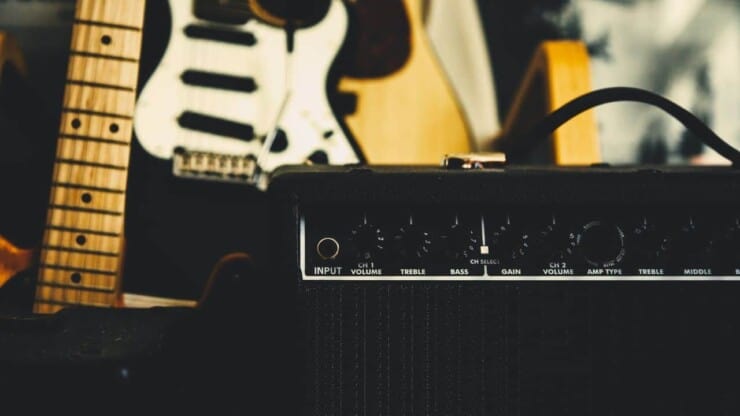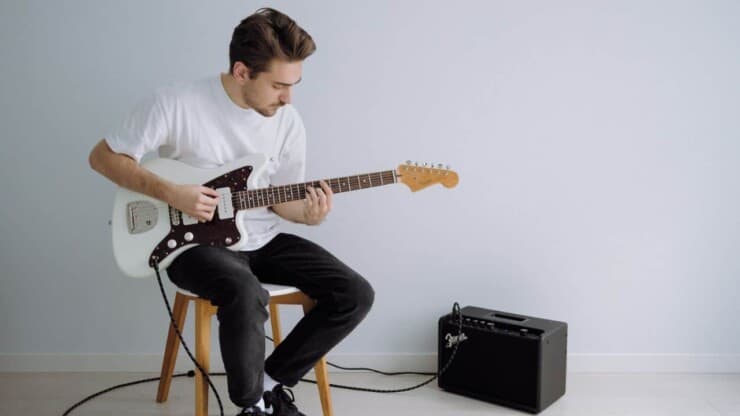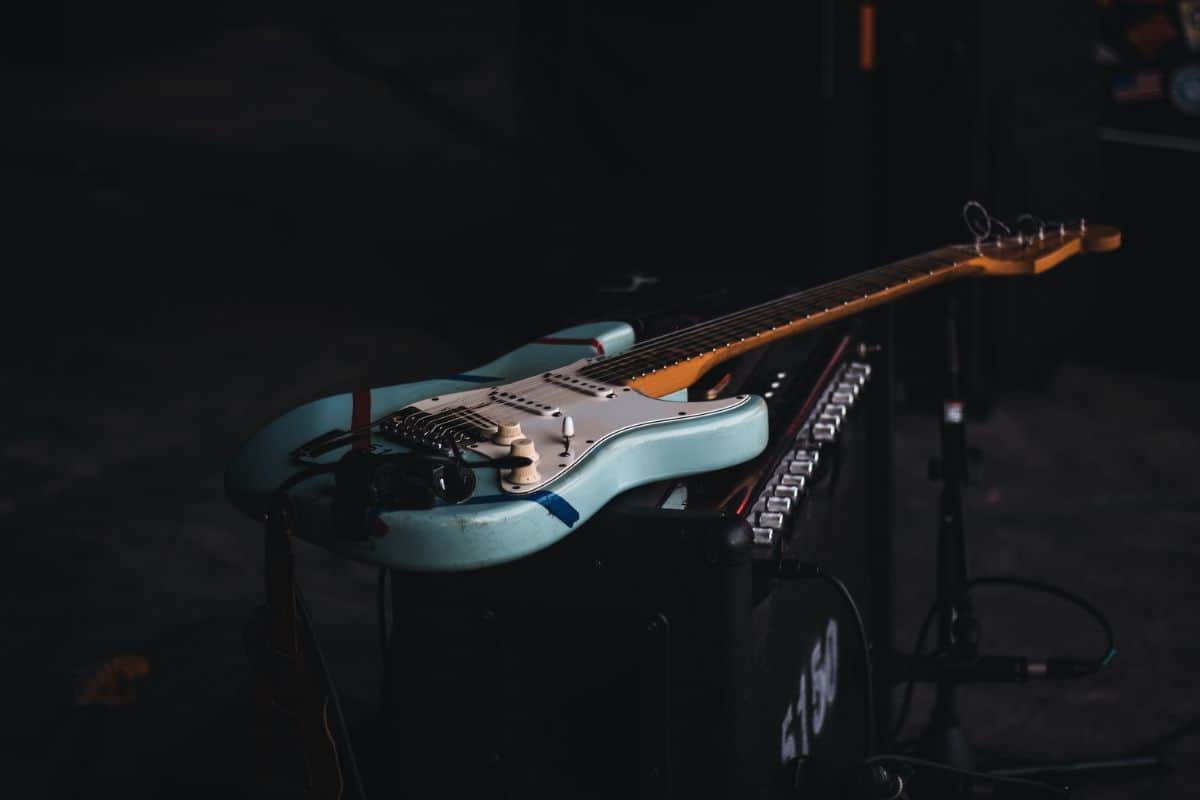Have you bought a new guitar amp that isn’t giving the expected sound, and you want to make it sound better? If so, then you’re definitely in the right place.
Making a guitar amp sound better is actually quite easy. All you’ll need to do is understand your amp, boost the mids, care for your cables, select the right pickup, and more. Use the right process, and you’ll be good to go.
In this article, you’ll get to know all about guitar amps, how to make a guitar amp sound better, tips on how to get the best tone from a tube amp, and more. Stick around to get all the answers that you’re looking for.
How to make a guitar amp sound better?
So, you’re looking for how to get the best tone from a tube amp, but you think that your amp is holding you back? If this sounds familiar, then you shouldn’t worry. There are tips on how to make guitar amp sound better that’ll help improve your guitar amp’s sound. It’ll improve the overall tone quality while making your amp sound better.
The easiest way how to make a guitar amp sound better is by decreasing the gain slightly and increasing the mids. You can even elevate the amp for improving the low-end. Then, position it farther from the guitar for reducing feedback.
Understand your guitar amp
Understanding your amp might sound obvious, but it’s one of the best things to do for a better sound. It is even more significant if you are rather new to electric guitars.
When guitarists first learn to play, they rely too much on the amp’s settings recommended by the manufacturer. Even though this can be a decent place to start, it doesn’t always allow you to create a unique tone. Moreover, it doesn’t help you make adjustments to the settings, as the recommended controls don’t sound spot on. Every amp is different, so you should ensure that you take time to consider its features and other things that you can alter by turning the controls up or down. Most guitar amps have these basic controls built-in: volume, gain, bass, treble, and mids.
If you aren’t sure where to start, it’ll be a good idea to return to the basics. Then, turn all the controls to 12 o’clock. This will give you a better place to start from and make further adjustments. You’ll probably be comfortable with volume and gain, but you need to be clear about what the other controls mean.
- Bass – It refers to the amount of low-frequency sound that the amp will play. Higher bass settings will make the tone thicker. However, if you go too loud, it’ll start sounding muddled and be difficult to pick out the notes.
- Treble – This will control the amount of high-frequency sound that you’re hearing through the amp. The higher the treble, the sharper will be the sound. This is good for clarity, but if you’re going too high, it’ll sound harsh and hard on the ears.
- Mids – This one is very obvious, and it’ll refer to the mid-frequency sound played through the amp. Low-mids can produce a rather scooped sound, while a higher-mid setting makes the tone beefier.

Ease off on the gain
Now that you know more about the guitar amp, it’ll be time to delve into the settings a bit more. One of the biggest reasons for a poor-sounding amp is to have the gain too high. Even if you feel that you need high gain, chances are that it wouldn’t need to be as high as you think. Even music genres like heavy metal will not go full blast on the gain. Musicians rely more on pedals instead of the amp to give them the needed extra boost when needed.
Having the gain too high could damage the clarity of your tone. Similarly, having too much distortion could make the chords muddled. It’ll be hard to hear when you’re actually changing chords if you have gone overboard with the gain. If you’re worried about losing the sound if you lower the gain, try to increase the volume or use pedals to help you out. You don’t need to lower the gain dramatically for getting an improvement in the tone. Try to dial it back by 1-2, and you’ll notice that it is sounding a lot better. Moreover, you won’t lose the effect that you were trying to achieve.
Boost the mids
If you have been looking into the amp settings, you’d have come across the term “scooped sound”. It means that the tone is quite hollow. It refers to a low-mid setting and a high treble and bass setting. This was quite popular back in the 80s and is occasionally still used in hard rock or metal. This type of tone might not be as bad when you are practicing on your own. However, when you throw other musical instruments into the mix, if you’re playing in a band, you’ll notice that you’re getting drowned out.
To avoid that, try to increase your mids. It’ll solve the issue if you were struggling to hear the guitar when playing in a band. If you increase it too much, your tone might have been slightly muddled. You should try to increase it until you’ve got to that point. Then, you can turn it back down to before you had noticed the muddled tone.
Placement will be key
Like most professional sound equipment, placement will be the key. The location where you’re putting the amp will greatly affect the sound and tone. Moving it slightly can give you a huge difference in the way your amp sounds. The great news will be that it’ll be a really quick thing to do. There are a few key things that you’ll need to consider with the amp placement such as the height, angle of the amp, distance from other sound equipment, the surface of the room you’ll be playing in, and more.
The height of the guitar amp from the floor can greatly affect the sound and tone. Most people simply have their guitar amps resting on the ground. However, the sound it produces will vary whether you’re playing on a carpet or on a hard floor. Having the amp resting on a stand can improve the tone you’ll be getting by improving the low-end sound output. You don’t need to elevate it too high in most cases. Only a few inches of the ground can make a whole lot of difference.
If you’re making your amp around, you should be careful when lifting it. Remember not to injure yourself, and ensure that you’re positioning it on something stable and capable of supporting the weight properly. You can always think of buying an amp stand as it’ll be a great choice to elevate your amp safely. The distance from other sound equipment, especially mics, can affect the amount of feedback you’re getting. Having your mic as far away from the amp as possible helps in reducing feedback. You can also try to have your amp at the front of the stage.
Think of adding pedals
Regardless of what amp you’re working with, whether it costs $50 or $5,000, it’ll have its own limitations. One of the main limitations of many amps is the number of controls that it comes built-in with. Most amps come with volume gain, bass, mids, treble, gain, and other controls. Meanwhile, some of them also come with effects like reverb, delay, and contouring. However, most amps will not give you enough options for customizations for you to create the perfect tone you’re after.
This is why effect pedals will be great. They’ll allow you to create unique sounds that pair well with your amp. It means that you can always rely on your amp for the basics and foundation of your tone. However, you can use effects pedals for adding another layer of depth. If you’re new to guitar pedals, there are certain things to know about them.
- Distortion pedals – These are rather straightforward, and they’ll add classic distortion and sustain that you would expect. They’re great to improve the sound. These pedals will give you a gain boost that your amp might not produce without sounding muddled. If you’re trying out distortion pedals, the Boss DS-2 Turbo Distortion Compact Pedal is a great option to start with.
- Overdrive pedals – These pedals are sometimes confused with distortion pedals, but they’re very different. These pedals imitate the sound you’d get if you turned a valve amp as high as it can go. They’ll give you a boost without actually overdoing the gain, making them suitable for country, blues, and lighter rock. An incredibly popular overdrive pedal that you can try out is the Ibanez Tubescreamer TS9. It is used by mainstream stars like Noel Gallagher and Alex Turner.
- Fuzz pedals – These pedals produce a fuzzy, noisy tone that is quite unique. These pedals were made popular by guitarists like Keith Richards, Jimi Hendrix, and Billy Corgan. They produce a characteristic tone without causing any muddling that would occur had you tried it with an amp. The Electro-Harmonix Op Amp Big Muff is widely considered to be a popular pedal in this category.
There are many other types of pedals that’ll help you create unique tones to complement your amp. Here are a few honorable mentions –
- Reverb pedals will give you an echo effect
- Delay pedals will take a chord or note and play it back repeatedly
- Boost pedals will allow you to increase the volume without using distortion
- EQ pedals will control your bass, treble, and mids
- Chorus pedals sound like multiple guitars being played at once
- Tremolo pedals will give the effect of increasing or decreasing the volume quickly
- Phaser pedals will add a type of whoosh noise to your guitar
Care for the cables
This might not sound like an important detail, but it’s important. In fact, this is one of the most important things if you want to make your guitar amp sound better. For starters, you should ensure you’re purchasing a high-quality cable for your guitar amp. Then, ensure that you’re storing it properly and avoiding damaging it while it is being used.
Causing kinks and bends or stretching the cable will lead to problems like unwanted distortion and feedback. One of the best ways to prevent that is by looking after the cables. This is one of the quickest and easiest ways how to make a guitar amp sound better. The best thing is that you won’t even have to invest a lot of extra time or money.
Choose the right pickup
Many guitarists think that the amp is what causes the tone to sound slightly rubbish. In a lot of cases, this isn’t actually the problem. Your pickups can end up being the culprit. On most guitars, there will be three settings. One that’ll allow you to use the bridge pickup in isolation, another one that’ll allow you to use the neck pickup in isolation. Then, there is another setting that’ll use both the neck and bridge pickups together.
- Bridge pickup – lead guitar: This sounds crisper and sharper
- Neck pickup – rhythm guitar: It sounds more bassy and smooth
There are different types of pickups as well. The main two are humbucker and single-coil. Single-coils are normally found on Fender Stratocasters whereas humbuckers are usually found on Gibson Les Paul guitars. Both of them produce very different tones. The primary difference is that single-coil will produce a brighter and crisper tone, whereas humbuckers will produce deeper and smoother tones.
Try to experiment using different pickup selectors on the guitar to figure out the tone that you want. It might be the actual pickups that you’re using that might not be capable of producing the tones that you’re after. For instance, you might want a twangy sound that you wouldn’t be able to achieve and use humbuckers instead of single-coil pickups. You might be looking for a beefier tone that your single-coil pickups aren’t as capable of. Changing your pickups won’t require a new guitar. You can easily do it yourself or take it to a technician for making the change.
How to adjust guitar amp tone?
The tone of an amp is essential, but so are the volume and sound quality. If you’re looking to play live, you’ll need enough volume so that you’re able to fill the venue with sound. How loud does the sound need to be?
For home use, you should use your amp to be around 20W. For most gigs and live performances in venues holding around 100 people, you should get either a 20W tube amp or a 40W solid-state amp. If you’re playing with a drummer, you’ll require a 50W tube amp or a 100W solid-state amp. For larger venues that can hold thousands of people, you’ll require a 100W tube amp or a 200W solid-state amp.

What affects the volume of a guitar amp?
There are multiple facts that affect the loudness of the guitar and help you know how to make guitar amp sound better. Such factors include wattage, cabinet size, type of amp, and more.
Wattage of the guitar amp
The reason why wattage is talked about when considering the volume is that it is one of the best ways to compare different amps. For understanding how wattage really works, you must go through the science behind it briefly. A watt is basically a unit of power. The more watts a guitar amp has, the more powerful it’ll be. There is a relationship between an increase in watts and an increase in sound levels. But does it mean that a 100W amp is automatically going to be louder than a 10W amp? Not really.
It’s important to consider the relationship between the number of watts and the loudness of the amp isn’t linear. For instance, a 100W amp will not be 10x louder than a 10W amp. In fact, the difference will be minimal. The difference in decibels (dB) between a 50W and a 100W amp will be around 3dB. To put it into perspective, the sound that your own breathing makes will be around 10dB. It’ll take an amp to have 10x more watts to be considered 2x as loud as most humans.
If you want to increase the power in watts by 100, it’ll result in a volume increase of just 20dB. This means that it’ll be 4x louder. For instance, a 10W amp will be twice as loud as a 1W amp. You’ll need a really big increase in the number of watts for getting a noticeable increase in volume. You shouldn’t choose a rubbish 50W amp over a comparatively better 40W amp just because you feel it’ll sound better. The truth is, it wouldn’t make a huge amount of difference.
The speaker cabinet
Their speaker cabinet and its dimensions will also be very important. For instance, a 100W amp played through a 1×12 cabinet sounds quieter when it is played through a 2×12 cabinet. This happens as the 2×12 cabinet generates twice as much air movement, which causes it to sound louder. Moreover, there are open back and closed-back cabinets as well. Open back will allow the sound to exit the speaker from the front and the back of the cabinet. It fills the room slightly more, which will be great if you’re playing in a comparatively larger venue. Closed-back cabinets will sound more focused as the sound is only coming from the front of the speaker.
Type of amp – Tube vs. Solid-State
The type of amplifier you’re using is important as well. It’ll be important to understand the difference between tube and solid-state amps when considering the volume and making it sound better.
Tube amps will generally sound louder than their solid-state counterparts when both of them have the same number of watts. This is the case as tube amps compress the sound, giving the impression that they’re louder. Tube amps tend to distort the sound when you crank up the sound. It’s this distortion that tricks the ears into thinking that it’s louder.
The reason it doesn’t happen with solid-state amps is as the distortion you’re hearing when you crank up the volume is more obvious. When you increase the volume of a solid-state amp, it sounds far more distorted. When you’re cranking the volume of a tube amp, it’ll sound louder instead of sounding more distorted.
Conclusion
Thank you for reading. Hopefully, now you know all about guitar amps, how to make a guitar amp sound better, tips on how to get the best tone from a tube amp, and more. If you’re a guitarist, you’ll be eager to find out how to make a guitar amp sound better. You’ll be glad to know that it’s actually easy. All you’ll need to do is understand the amp, boost the mids, care for the cables, and choose the right pickup.



